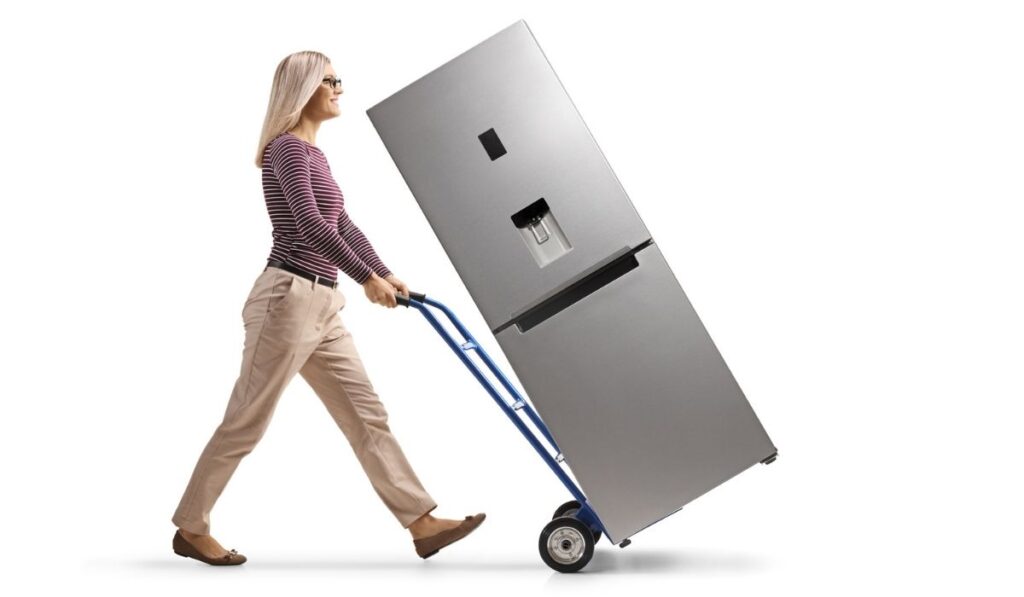When it comes to moving a refrigerator, it’s very important to consider the proper way to hold it. Getting it right will protect your fridge from damage and ensure you don’t end up with a faulty appliance on your hands. Laying the refrigerator on its back may seem like the easiest way to proceed, but is that a good idea?
It would be best if you didn’t lay a refrigerator on its back when moving it. Doing so could damage the most sensitive parts of the fridge, which are housed in the back. The best way to transport a refrigerator is by keeping it upright or, if that isn’t an option, on its side.
Moving a fridge isn’t as simple as you might expect. There are several considerations to make when getting your fridge from point A to point B. Let’s take a look at the process so that you can be prepared for your next move.
Can You Lay a Fridge on Its Back?

It’s not advisable to lay a fridge on its back while transporting it. This is because almost all the electrical components of the refrigerator are located at the back.
Hence, resting the appliance’s weight on those components can damage it and prevent the machine from working effectively.
The best way to transport a refrigerator is upright, especially if you’re moving it to a distant location. This method isn’t always possible, so you can also choose to lay the fridge on its side. This is much better than laying it on its back.
Can You Lay a Refrigerator on Its Side Instead?
Usually, the best way to move a fridge is by keeping it upright, as we mentioned, but you may not always have the luxury of that option. In that case, the only other option is to lay the appliance on its side.
However, a note of caution: Laying a refrigerator on its side can cause the compressor oil to flow out and into the coolant lines. This can affect the unit and hinder the proper functioning of the fridge.
You can stop this by laying the appliance on the side opposite the compressor line. If the compressor is on the left side, you should lay the fridge on its right side.
How to Properly Move a Refrigerator
As a homeowner, it’s essential to know how to move a refrigerator properly. This will ensure that you don’t damage any parts of the appliance, and you don’t have to worry about fixing anything later on. Below are some of the ways to properly move your fridge.
Ensure the Fridge Is Empty
While this might sound obvious, many homeowners forget to empty their fridges and move them with everything inside. Before you move a refrigerator, one of the first things to do is empty it.
Eat whatever you can and perhaps keep the rest somewhere else until you can move it back into your fridge. Doing this will not only make the appliance lighter and easier to move, but it’ll also keep it clean for use.
Melt the Ice
There are different reasons why you should allow the ice in your refrigerator to melt before moving it. For one, it will make the appliance less challenging to move.
Also, you won’t have to worry about water or ice getting into certain parts of the fridge and damaging something. Turn the refrigerator off hours before moving to allow the accumulated ice to defrost. Then wipe off the residue.
Remove the Shelves
If you leave shelves in the refrigerator, they’ll move around while you’re in transit and could damage something. To avoid this, remove any shelves before moving the fridge, and if you can’t remove them, tape them firmly to the walls of the refrigerator.
Tape the Refrigerator Door
If the refrigerator door isn’t tightly shut, chances are you’ll have to deal with the door opening at intervals while in transit. If this happens often, the hinges, door handles, and even the door itself can be damaged.
It’s best to secure the door with tape, rope, or twine to stop the refrigerator door from opening while it’s being transported.
Ask for Help
Once your refrigerator’s been emptied, you might begin to think that the appliance is relatively light and that you could move it yourself with a trolley. Don’t get overconfident! Refrigerators are large and heavy, and a helping hand is key.
Since you need to be careful not to damage anything (including yourself), you should ask for help when it’s time for you to move the fridge.
If you can afford it, you can also use a moving company to help you transport the refrigerator. They will handle the appliance with care so that you don’t have to worry about any possible damage.
Keep the Fridge Vertical
If you can, you should try to keep the refrigerator vertical when you’re moving it to somewhere far away. You can still lay it down for short distances, but that should be on its side or front, never on its back.
Doing the latter can cause oil and gas to leak into other parts of the fridge and damage something. Furthermore, if you lay a refrigerator on its back, its weight can affect some of the fridge’s components. So try to keep the refrigerator vertical if possible.
In the same vein, you should keep your refrigerator unplugged for a few hours after moving it to allow for the oil and gas to move back to their normal positions.
Be Gentle
As big as a refrigerator is, it’s also a delicate appliance that should be handled with care. For this reason, you have to be very gentle when you’re moving it. You can achieve this by wrapping a blanket around it to protect it from potential impact while it’s being moved.
How Do You Fix a Refrigerator That Was Lying Down?
If you lay your refrigerator while moving it, oil from the compressor can get into the cooling lines. After transporting your fridge in that position, keep it upright for at least 24 hours before plugging it back in. This will give the oil more than enough time to move back into the compressor.
Why Do You Have to Wait 24 Hours to Plug in a Fridge?
The oil in the compressor coagulates when a fridge is left out in cold air for too long. The fragile parts and fluids of the refrigerator need time to settle, especially if the refrigerator has been turned onto its side.
Leaving your fridge unplugged for at least 24 hours before using it again minimizes the risk of it being damaged and helps you save on repairs. Not waiting this long can affect the compressor, which will affect other parts of the machine and ultimately the device itself.
How Do You Transport a Fridge in a Car?

It would help if you transported a fridge in an upright position in a car. However, if this position can’t be achieved, you can tilt it on its side. Don’t lay it on its back.
Conclusion
No one wants to deal with a faulty appliance, especially if that appliance is as crucial as a refrigerator. A damaged fridge will lead to spoiled food items and medicine, and some can even make annoying beeping noises. The compressor is also a very important component that can be negatively affected if you handle your refrigerator carelessly.
So, to avoid issues with your fridge, pay attention to how you move it and avoid plugging it in immediately after installing it.
